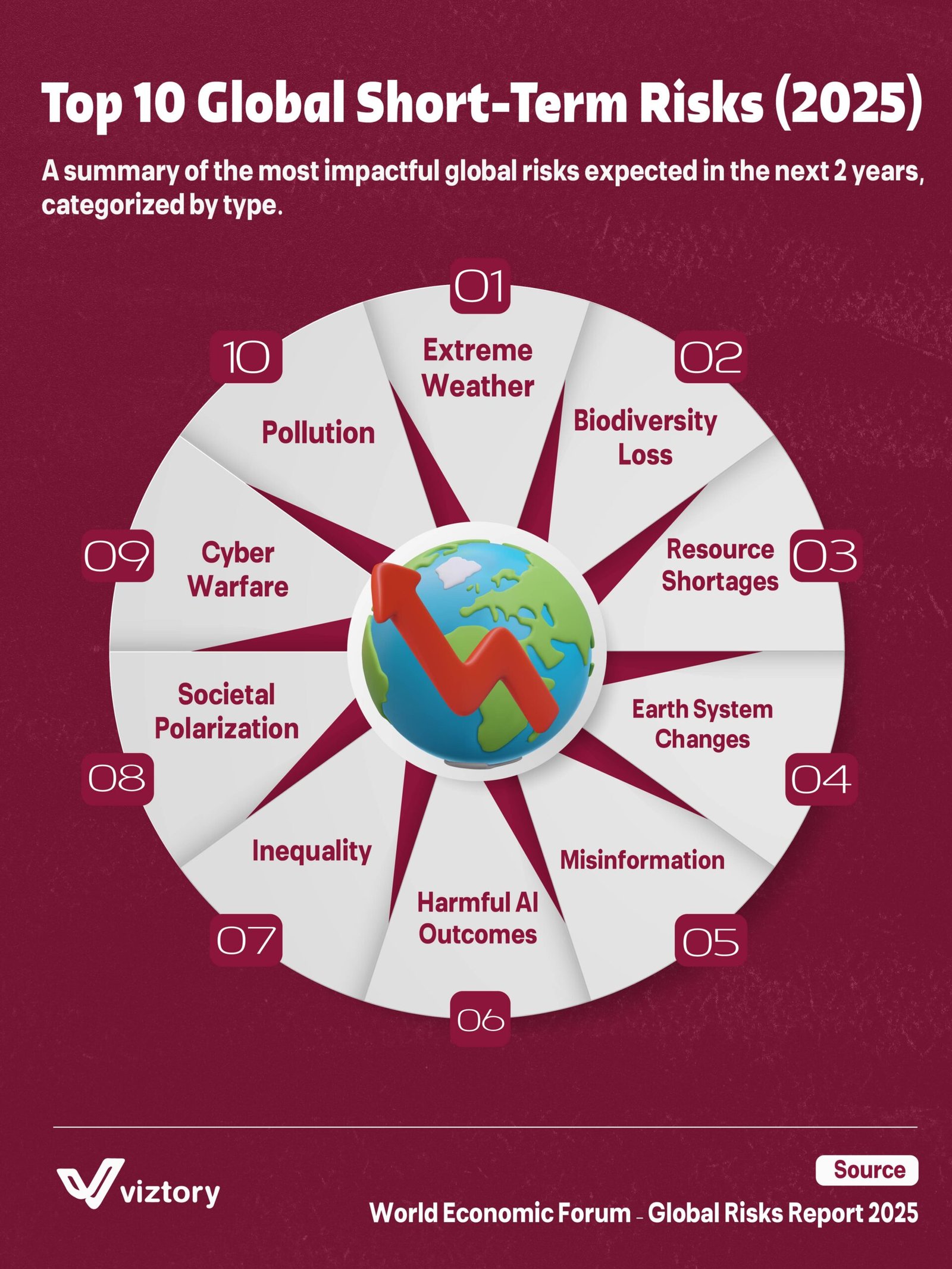Top 10 Global Short-Term Risks (2025)
Introduction
The image, designed by Viztory and sourced from the World Economic Forum – Global Risks Report 2025, outlines the top 10 short-term global risks anticipated to shape the world within the next two years. From climate disruptions to digital dangers, each threat carries massive implications for individuals, businesses, and global markets—especially when viewed through the lens of money and financial stability.
This isn’t just a list of what could go wrong. It’s a financial forecast in disguise—highlighting where economies might bleed and where proactive investment is not just wise, but essential.
The Risk Wheel – A Quick Look
Here are the 10 most pressing short-term global risks for 2025, arranged clockwise from the top:
-
Extreme Weather
-
Biodiversity Loss
-
Resource Shortages
-
Earth System Changes
-
Misinformation
-
Harmful AI Outcomes
-
Inequality
-
Societal Polarization
-
Cyber Warfare
-
Pollution
Risk Meets Capital: Financial Repercussions
1. Extreme Weather = Economic Havoc
Floods, fires, and hurricanes aren’t just humanitarian disasters—they drain billions from economies through insurance claims, lost productivity, food price shocks, and displaced populations. Investors are fleeing high-risk regions, and governments must reallocate money from growth to recovery.
2. Biodiversity Loss & 3. Resource Shortages
The collapse of natural ecosystems threatens industries from agriculture to pharmaceuticals. When bees vanish, crop yields plummet. When rare minerals dry up, tech supply chains collapse. Result? Higher prices, lower margins, and panic in commodities markets.
4. Earth System Changes
Long-term climate shifts (ice melts, rising sea levels, desertification) affect real estate, tourism, agriculture, and infrastructure investment. Entire business models will need to adapt—or vanish.
Digital Threats
5. Misinformation
Fake news isn’t just a social issue—it’s a market-moving force. False data or manipulated narratives can cause stock crashes, voter manipulation, and public distrust in financial systems. The cost of combating misinformation in 2023 already topped $78 billion.
6. Harmful AI Outcomes
From biased algorithms in loan approvals to autonomous systems making flawed business decisions, AI errors can destroy corporate reputations—and portfolios. Smart money is flowing into AI audit systems and ethical oversight platforms.
9. Cyber Warfare
A major attack on financial institutions or national infrastructure could trigger a global recession. In 2024, the average cost of a corporate data breach was $4.45 million—but nation-state attacks could cost hundreds of billions.
Human & Social Risks
7. Inequality
The widening gap between rich and poor triggers unrest, economic inefficiency, and political instability—an indirect but powerful destroyer of wealth.
8. Societal Polarization
Political gridlock, riots, and lack of social cohesion delay policy implementation, hinder trade agreements, and scare off investors.
10. Pollution – The Silent Drainer
Air and water pollution reduce labor productivity, increase healthcare costs, and deter foreign investment. A 1% rise in air pollution has been shown to cut GDP by up to 0.2% in developing countries.
Analysis: Where Money Should Go
-
Climate Resilience: Flood-proof cities, green tech, sustainable agriculture.
-
Digital Security: Cybersecurity, AI governance, misinformation filtering.
-
Social Infrastructure: Education, fair access to technology, healthcare equality.
Smart investors and policymakers are already channeling capital toward resilience, not just recovery. The difference between thriving and surviving in 2025 lies in understanding these risks as economic signals.
Conclusion
The “Top 10 Global Short-Term Risks (2025)” chart isn’t just a grim forecast—it’s a financial compass. Every risk listed represents not only a challenge but a market opportunity, an area for public-private collaboration, and a call for economic preparedness.
When climate meets capital, and code meets culture, the future isn’t just about weathering storms—it’s about investing in solutions. In the world of global risk, money doesn’t just respond—it leads.

